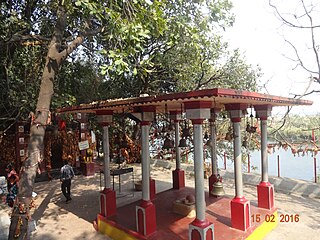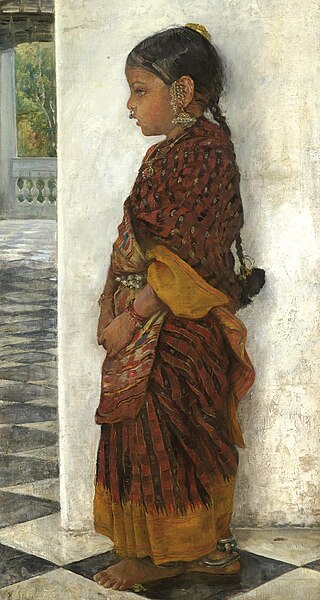Related Research Articles

Sambalpur District is a district in the western part of state of Odisha, India. The historic city of Sambalpur is the district headquarters.
The Indian state of Odisha has a rich cultural and artistic heritage. Due to the reign of many different rulers in the past, arts and crafts in Odisha underwent many changes giving an artistic diversity today in the forms of traditional handicrafts, painting and carving, dance and music, clothing, etc.

A Sambalpuri sari is a traditional handwoven bandha (ikat) sari wherein the warp and the weft are tie-dyed before weaving. It is produced in the Sambalpur, Balangir, Bargarh, Boudh and Sonepur districts of Odisha, India. The sari is a traditional female garment in the Indian subcontinent consisting of a strip of unstitched cloth ranging from four to nine metres in length that is draped over the body in various styles.

Dr. Haldhar Nag is a Sambalpuri poet and writer from Bargarh, Odisha, India. Popularly known as "Lok kabi Ratna". He was awarded Padma Shri, the fourth highest civilian award of India by Government of India in 2016. He was born in a poor family of Ghens. He is best known for his work Kavyanjali, an anthology of English translation of Nag's selected poetry which was launched on 2 October 2016. Recently he released his 3rd volume of work on Kavyanjali. In 2019 Haldhar Nag was awarded Doctorate Degree by Sambalpur University. In the year 2020, Professor Jaishankar Babu, Head of the Department of Hindi, Pondicherry University, organized a two-day international seminar under the guidance of its Vice-Chancellor Professor Gurmeet Singh, in which "Haldhar Nag Ka kavya- Sansar" translated into Hindi from Sambalpuri by renowned Hindi writer-cum-transaltor Dinesh Kumar Mali was released and there was an intensive discussion on his poems by the participants from India and abroad. In the year 2021, under joint editorship Professor Jaishankar Babu and translator Dinesh Kumar Mali, the book "'Haldhar ke Lok-sahitya par vimarsh'" and the book "Ramayan prasangon par Haldhar ke Kavya aur yugin Vimarsh " translated by Dinesh Kumar Mali based on Ramayana contexts. published from Pandulipi Prakashan, New Delhi.The popularity of these books Hindi Belt honored Haldhar Nag with Dr. Ram Manohar Tripathi Lok Seva Samman on the Silver Jubilee eve of Acharya Mahavir Prasad Dwivedi Smruti Sanrakshan Abhiyan under the leadership of Gaurav Awasthi in the auditorium of Firoz Gandhi College, Rae Bareli on date 12.11.22. The Indira Gandhi National Open University (IGNOU) has included a review of literary creations of Padma awardee and noted poet Haldhar Nag. According to sources, students pursuing a Master of Arts (MA) in Folklore and Culture Studies will study folk literature by Nag in a course component titled, ‘Folklore: Canon, Multimediality, Interdisciplinarity, and Social Epistemology’ in their second year.The course book has described Nag as the true representative of orality in the present times. His creations have been reviewed in the category, ‘Case study of orality from East India’.“Nag has based his poems on his surroundings. Folklorists and folklore researchers are vulnerable to multiple challenges with regards to archiving, documentation, and dissemination of the folk material,” TOI reported writer Nandini Sahu, who has designed the MA course for IGNOU, as saying.Notably, writer Dinesh K Mali has written a chapter for the MA programme on Nag’s poetry.'
Sambalpur, in Orissa, India, is a region that has a distinct cultural identity. The songs, clothing, dances, language and festivals celebrated in Sambalpur are unique. This distinct cultural identity arises from the strong association of the tribal and folk communities which have been coexisting in Sambalpur for centuries.

Pochampally sari or Pochampalli ikat is a saree made in Bhoodan Pochampally, Yadadri Bhuvanagiri district, Telangana State, India. They have traditional geometric patterns in "Paagadu Bandhu" (Ikat) style of dyeing. The intricate geometric designs find their way into sarees and dress materials. The Indian government's official airplane company, Air India, has its cabin crew wear specially designed Pochampally silk sarees.

Gajam Anjaiah, an Indian master handloom designer, who is widely recognised in the handloom industry for his innovations and developments of Tie and Dye handloom products along with Telia Rumal technique of weaving based on Ikat tie-dye process. He received Padma Shri from Government of India under Art category in 2013. He is known for his excellence in traditional handloom design works, such as Puttapaka Sarees in Tie and dye skill, that is the traditional art of designing on paper and then transferring it on to cloth. His dedication to the Handloom Industry has kept the Indian tradition of weaving alive, brought livelihood to the weavers and gave exclusive/unique designed handloom products to the people in India.
Puttapaka Sari is a saree made in Puttapaka village, Samsthan Narayanpuram mandal in Nalgonda district, India. It is known for its unique Puttapaka tie and dye style of sarees.

Kailash Chandra Meher is an Indian artist, inventor, and social activist. He is a painter of contemporary modern art paintings and traditional Tussar Pattachitra paintings of Odisha. He was a recipient of the Padma Shri by the Government of India in 2013.
Gajam Govardhana is an Indian master weaver, known for his work in Ikkat dyeing in the Telia Rumal tradition, and for his handloom creations. In 2011 the government of India honoured him with the fourth-highest civilian award, Padma Shri.
Laila Tyabji is an Indian social worker, designer, writer, and craft activist. She is one of the founders of Dastkar, a Delhi-based non governmental organization, working for the revival of traditional crafts in India. She was honored by the Government of India in 2012 with the Indian civilian award of Padma Shri. She is the daughter of late Badruddin Tyabji, ICS, who was a senior Indian civil servant and diplomat.

Handloom saris are a traditional textile art of Bangladesh and India. The production of handloom saris are important for economic development in rural India.
Jadunath Supakar was an Indian artist and textile designer. He was born in 1931 in Sambalpur in the Indian state of Odisha and was known for his contributions for the popularization of handloom industry of Varanasi. He was a recipient of the Odisha Lalit Kala Academy Award and his creations have been exhibited in several countries. The Government of India awarded him the fourth highest Indian civilian honour of Padma Shri in 1985. His son, Sribhash Chandra Supakar, is also a textile designer and a national award winner.
Chaturbhuj Meher is an Indian weaver, considered by many as one of the master weavers of the Tie-dye handloom tradition of Odisha. Born on 13 October 1935 at Sonepur in Odisha, he had formal education only up to school level but learned the traditional weaving craft to join Weavers' Service Centre as a Weaver. Vayan Vihar, a handloom factory and Handloom Research and Training Center, a research institute in Sonepur have been founded by him and he is known to have trained over 10,000 craftsmen.
Bhulia is an Indian Hindu caste originally from western Odisha but presently found throughout Odisha.

Habaspuri is a cotton-based traditional handloom textiles of Odisha, India. Habaspuri sari is a major product of this textile. The Bhulia weavers of Chicheguda, Kalahandi district, Odisha are originally attributed for weaving of the Habaspuri fabric. For its uniqueness in weaving, design and production, it has been identified as one of the 14 Geographical Indications of Odisha. The textile has traditional patterns of the region like kumbha (temple), fish and flowers.

Odisha Ikat, is a kind of ikat known as Bandhakala and Bandha, a resist dyeing technique, originating from Indian state of Odisha. Traditionally known as "Bandhakala"', "Bandha", '"Bandha of Odisha", it is a geographically tagged product of Odisha since 2007. It is made through a process of tie-dying the warp and weft threads to create the design on the loom prior to weaving. It is unlike any other ikat woven in the rest of the country because of its design process, which has been called "poetry on the loom". This design is in vogue only at the western and eastern regions of Odisha; similar designs are produced by community groups called the Bhulia, Kostha Asani, and Patara. The fabric gives a striking curvilinear appearance. Saris made out of this fabric feature bands of brocade in the borders and also at the ends, called anchal or pallu. Its forms are purposefully feathered, giving the edges a "hazy and fragile" appearance. There are different kinds of bandha saris made in Odisha, notably Khandua, Sambalpuri, Pasapali, Kataki and Manibandhi.
Kotpad Handloom is a vegetable-dyed fabric woven by the tribal weavers of the Mirgan community of Kotpad village in Koraput district, Odisha, India. Cotton sarees with solid border and Pata Anchal, duppatta with typical Buties / motifs, Scolrfs on cotton, silk, handloom stoles, and dress materials are all dyed with organic dyes. The natural dye is manufactured from the aul tree grown in this area. The Kotpad tussar silk saree with tribal art and Kotpad handloom fabrics with natural color is its specialty.

Gopalpur is a village known for producing Tussar fabrics. It is in Jajpur District in the Indian state of Odisha. This handicraft received the Geographical Indication tag by the Government of India in 2009. Tussar textiles are related to dhoti, joda, Shawl stole, scarves and saris.
Gobardhan Panika is an Indian master weaver of Kotpad handloom a traditional tribal craft. The Government of India awarded him the fourth highest civilian honour of the Padma Shri, in 2018, for his contributions to the art of weaving.
References
- ↑ "Meet the Weavers and Dyers of Ikat". Strand of Silk. 2015. Archived from the original on 4 March 2016. Retrieved 27 October 2015.
- ↑ "ECourts" (PDF). ECourts. 2015. Archived from the original (PDF) on 16 October 2015. Retrieved 27 October 2015.
- ↑ "Surendra Kumar Meher". Paramparik Karigar. 2015. Retrieved 27 October 2015.
- ↑ "Sambalpuri Sari: Living tradition". Meri News. 20 November 2008. Archived from the original on 22 January 2016. Retrieved 27 October 2015.
- ↑ "Padma Awards" (PDF). Ministry of Home Affairs, Government of India. 2015. Archived from the original (PDF) on 15 October 2015. Retrieved 21 July 2015.
- ↑ "National Awards for the year 2009". National Centre for Textile Design. 2015. Archived from the original on 4 March 2016. Retrieved 27 October 2015.
- ↑ "Sant Kabir Award-2013" (PDF). Handloom Corporation of India. 2015. Retrieved 27 October 2015.